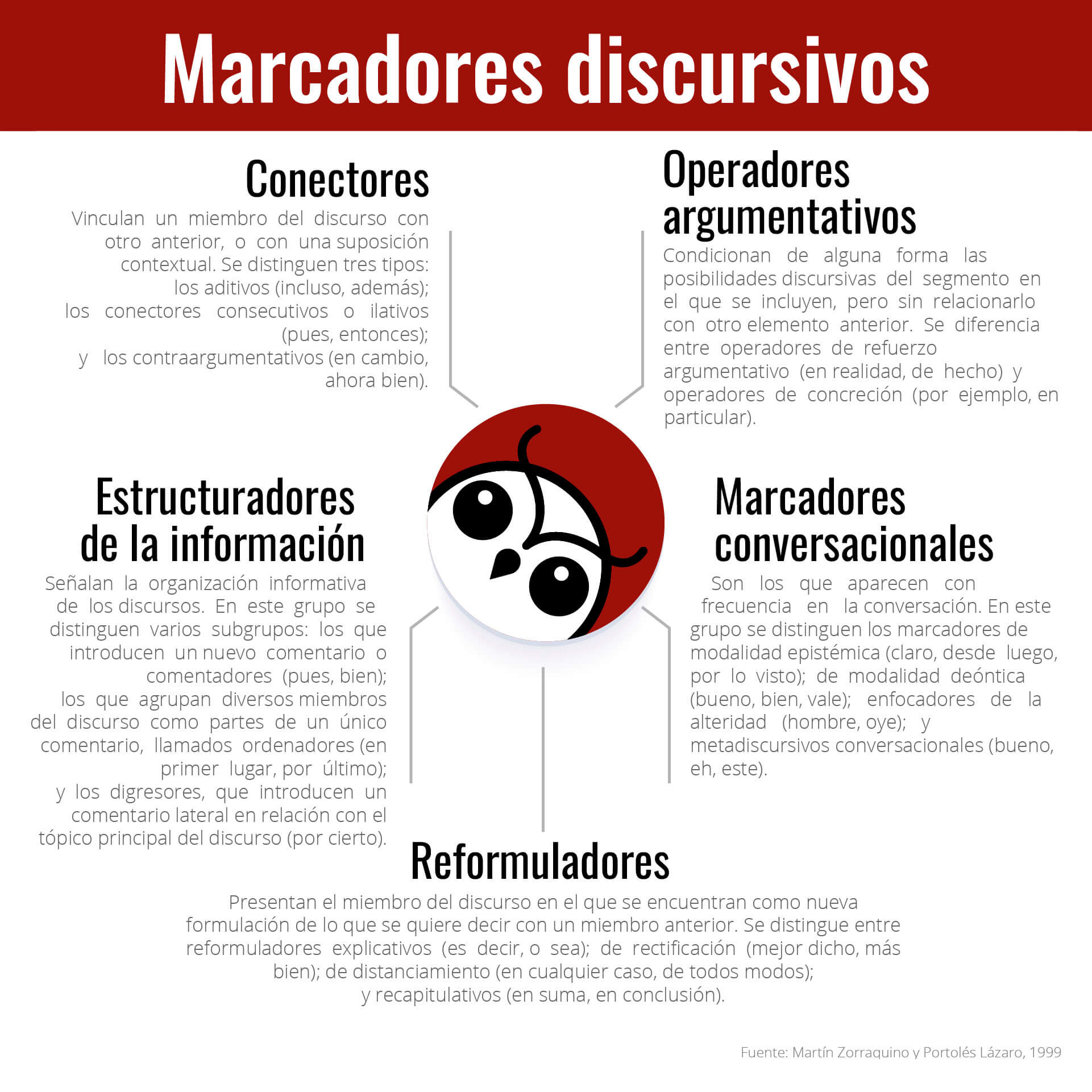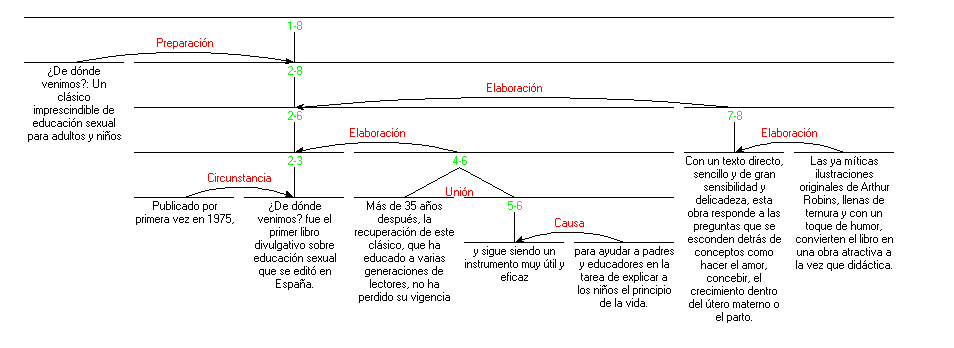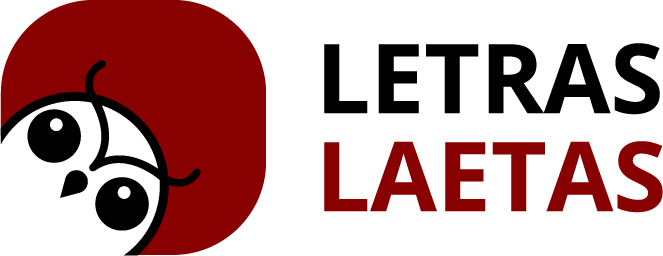In our everyday language we use sentences that have different types of relationships between them. We use the word ‘but’, to express an opposition; ‘for’, to express a purpose; ‘therefore’, to express a consequence… this peculiar group of words is known as discourse markers.. In this post we will address the following topics:
- What are discourse markers?
- Classification of discourse markers
- Using discourse markers to organize information
- Types of relationships in a discourse
What are discourse markers?
Discourse markers are a group of words made up of conjunctions, adverbs, prepositions and other elements that help us join sentences and give them meaning. They can be defined as:
Invariable linguistic units, they do not exercise a syntactic function in the framework of sentence predication —they are, therefore, marginal elements— and they have a coincident role in discourse, that of guiding, according to their different morphosyntactic, semantic and pragmatic properties, the inferences made in communication. (Martín Zorraquino and Portolés Lázaro, 1999, §63.1.2).
Discursive markers or connectors do not form a syntactic class of words, but they do form a linguistic group with certain characteristics. This group is made up of sentence verbs, conjunctions and adverbs whose function is “to inform about the way in which the propositional content of the sentence should be interpreted”.
Due to the fact that in natural language they serve as a guide to infer the intention or perception that a speaker has when connecting two statements, they are the greatest clue that a text has to determine the type of relationship that some sentences establish with others with others.
Knowing these markers help us to write properly, to argue well, to give meaning and intention to our speech and therefore, help our interlocutors understand what we want to communicate.
Classification of discourse markers
The most accepted classification of discourse markers for Spanish is the one proposed in the Gramática descriptiva de la lengua española in the chapter by Martín Zorraquino and Portolés Lázaro (1999):

Information structurers
They indicate the informative organization of the speeches. Several subgroups are distinguished in this group:
- Commentators. They introduce a new comment: pues, bien.
- Ordenators. They group various members of speech together as parts of a single comment: en primer lugar, por último.
- Digressors. They introduce a lateral comment in relation to the main topic of the speech: por cierto.
Connectors
They link one member of the discourse with a previous one, or with a contextual assumption. Three types are distinguished:
- Additives. They add information: incluso, además.
- Consecutive or illative. They show a logical cause or consequence: pues, entonces.
- Counter argumentatives. They keep an adversative relation: en cambio, ahora bien.
Reformulators
They present the member of the discourse in which they find themselves as a new formulation of what is meant by a previous member. It distinguishes between:
- Explanatory. Es decir, o sea.
- Of rectification. Mejor dicho, más bien.
- Of distancing. En cualquier caso, de todos modos.
- Recapitulatives. En suma, en conclusión.
Argumentative operators
They condition in some way the discursive possibilities of the segment in which they are included, but without relating it to another previous element. It is differentiated between:
- Argumentative reinforcement operators. En realidad, de hecho.
- Concretion operators. Por ejemplo, en particular.
Conversational markers
They are the ones that appear frequently in the conversation. In this group are distinguished:
- Of epistemic modality. Claro, desde luego, por lo visto.
- Of deontic modality. Bueno, bien, vale.
- Focussers of alterity. Hombre, oye.
- Conversational metadiscursives. Bueno, eh, este.
Using discourse markers to organize information
Whether we are writing a thesis, a corporate document, a magazine article, or a blog post, using these transition words can help us organize information. Using them well makes it easy for readers to understand what you mean. Below we present a discursive scheme that contains various examples of the use of these markers.

As we could see in the previous example, there are different types of relationships between the parts of a speech. Use markers helps us structure the information:
- Titles and subtitles are a preparation for the topic to be discussed.
- Union relations can be expressed with markers of the additive type, such as the conjunction “and”.
- Causal relations can justly be expressed by causal markers, such as “for”.
- Some authors call elaborations to the development of arguments and ideas from something that has been previously said.
Types of relationships in a discourse
Bill Mann and Sandra Thompson, a couple very scholars of discourse and computational linguistics, create the Rhetorical Structure Theory. This theory holds that all discourse can be divided into minimal units (Elementary Discourse Units), and that these EDU’s have two types of relationships with each other:
a) Mononuclear relations, with a single nucleus, for example: “I went to the party since it was essential”. The nucleus would be “I went to the party”; “Since it was indispensable” would be a satellite or information tangential to said nucleus.
b) Multinuclear relations, with more than one nucleus, for example, “I ate, I drank and I danced”. Each of the verbs would constitute relevant information, that is, each one is a nucleus.
These relations in many cases, are preceded by the discourse markers.
Mononuclear relations
Alternative: It is a disjunction to what is presented in the core. For example:[Consideramos que el programa tenía cobertura total si incluía a todos los municipios]NUCLEUS [si no, la cobertura del programa era considerada parcial]ALTERNATIVE_SATELLITE
Antithesis: The satellite presents an adverse idea to its nucleus. For example:[La relación entre las lesiones deportivas y psicológicas ha sido estudiada desde diversas perspectivas]NUCLEUS [pero los hallazgos han sido contradictorios debido a problemas metodológicos]ANTITHESIS_SATELLITE
Cause: It is the reason, foundation or origin of something that is mentioned in the nucleus. For example: [La psiconeuroinmunología es un nuevo campo de la ciencia que está emergiendo]NUCLEUS [debido a un número cada vez mayor de datos que demuestran interrelaciones entre funciones inmunes y psiconeuronales]CAUSE_SATELLITE
Circumstance: Presents tangential information about time, place, mode, etc. For example: [La recolección de datos se realizó]NUCLEUS [antes de que las mujeres fueran informadas sobre su diagnóstico]CIRCUMSTANCE_SATELLITE
Condition: Indicates an indispensable situation for the existence or development of a nucleus. For example: [Si despejamos la ecuación]CONDITION_SATELLITE [obtenemos lo siguiente x=V*i=i]NUCLEUS
Concession: Presents information that seems contrary to the core but is actually complementary. For example: [En este trabajo se presenta un caso clínico cuya queja inicial estaba relacionada con un diagnóstico de depresión;]NUCLEUS [aunque el problema tenía que ver con relaciones de pareja]CONCESSION_SATELLITE
Elaboration: The development of an idea or argument from something that has already been said. For example: [Los hallazgos han sido contradictorios debido a problemas metodológicos]NUCLEUS [como no contar con muestras homogéneas]ELABORATION_SATELLITE
Evaluation: In this satellite the author or speaker offers a value judgment about something said in the core. For example: [Entonces se debía buscar una manera de juntar los números reales con los imaginarios]NUCLEUS [(hasta suena bonito)]EVALUATION_SATELLITE
Evidence: This satellite offers evidence that supports the truth of what its core says. For example: [Presentaron datos clínicos de obstrucción intestinal once pacientes.]NUCLEUS [En todos ellos se observaron signos radiológicos de obstrucción]EVIDENCE_SATELLITE
Background: Gives an account of a context or background that the reader must know before addressing a topic. For example:{ [(La relación entre las lesiones deportivas y psicológicas ha sido estudiada desde diversas perspectivas,)NUCLEUS (pero los hallazgos han sido contradictorios debido a problemas metodológicos.)ADVERSATIVE_SATELLITE] BACKGROUND_SATELLITE [El objetivo de este estudio fue conocer la influencia de las lesiones en la ansiedad, la autoconfianza, la evaluación del rendimiento hecha por terceros y la concentración] }NUCLEUS
Medium: It is the action or series of actions through which what is said in the nucleus is carried out. For example: [El artículo examina la relación entre la personalidad tipo C o propensa al cáncer (…) mediante sus características de personalidad]NUCLEUS [A una muestra de 480 mujeres (…) que habían asistido a remisión mamaria se les administró la escala de Racionalidad / Defensividad Emocional y la escala de Necesidad de Armonía]MEDIUM_SATELLITE
Motivation: This satellite establishes the factors by which the author or speaker develops what is said in the core. For example: [En contraste con las numerosas propuestas terapéuticas, sorprende que la pérdida de peso mediante una dieta alimentaria hipocalórica aparezca en un segundo o tercer plano]NUCLEUS [Por este motivo, nos hemos decidido a comunicar nuestra experiencia con la dieta hipocalórica como tratamiento único en pacientes afectos de OSAS]MOTIVATION_SATELLITE
Preparation: It is a title, subtitle or any other element that helps to order the speech, anticipating to the reader the topic that will be treated next. For example: [Introducción]PREPARATION_SATELLITE [En el ámbito de la lexicología es frecuente encontrar ambigüedades terminológicas]NUCLEUS
Purpose: This satellite shows the reason or purpose of what is said in the core. For example: [Todos estos aprendizajes servirán en las siguientes unidades]NUCLEUS [para mejorar, resolver, plantear, interpretar y aplicar diferentes procedimientos (…)]PURPOSE_SATELLITE
Reformulation: This type of satellite repeats the information presented in the core in other words, to make a point clear. For example: [Se incluyeron sólo pacientes que se consideraba eran estables,]NUCLEUS [es decir, que no habían precisado su medicación habitual en los últimos 15 días y clínicamente no referían un empeoramiento importante]REFORMULATION_SATELLITE
Solution: This satellite provides a solution to a problem raised in the core. For example: [Muchos estudiantes de secundaria tienen dificultad para las matemáticas y reprueban esta asignatura.]NUCLEUS [La solución a este problema es hacer las clases más interesantes.]SOLUTION_SATELLITE
Contextual mononuclear relationships
The authors of this theory authorize the use of more or less relationships. Below we present the original list that the authors of the RST consider, but that can be replaced by others. For example, a justification can be seen as a purpose. A summary and a training can be seen as elaborations. The interpretation differs from a cause in that it is an opinion. The result differs from the cause when it is the consequence of a previously expressed process or sequence.
Training: Provides information or instructions on how to do something. For example: [Al paciente no solo se le ha de diagnosticar y tratar la infección]NUCLEUS [Es necesario ofrecerle pautas para que dicha infección no vuelva a aparecer]TRAINING_SATELLITE
Interpretation: It is the explanation of something previously said or found, such as the analysis of results, without issuing a value judgment. For example: [La utilización de técnicas como el lavado gástrico aumenta el riesgo de rotura de los paquetes]NUCLEUS [por lo que se desaconseja su uso]INTERPRETATION_SATELLITE
Justification: It is the explanation of why something is done or affirmed. For example: [Estos resultados deben tomarse con precaución,]NUCLEUS [ya que se necesitan más investigaciones controladas]JUSTIFICATION_SATELLITE
Result: It is the consequence of an event, method or experiment. For example: [Mediante un análisis multivariante discriminante se apreció que los futbolistas lesionados graves o muy graves tuvieron mayores niveles de ansiedad, menor autoconfianza y estaban más afectados por la evaluación de los otros, que el resto de jugadores]RESULT_SATELLITE
Summary: Offers a reduction or recapitulation of what has been said previously. For example: {[Se realizó una radiografía simple]LIST_NUCLEUS [También se llevó a cabo una radiografía combinada mediante varias técnicas]LIST_NUCLEUS}NUCLEUS {En resumen, se han aplicado diferentes pruebas radiológicas}SUMMARY_SATELLITE
Unless: As its name indicates, this relationship is a condition with the value of something that can only occur unless that condition is met. For example: [Los terapeutas deben admitir a cualquier paciente en el grupo]NUCLEUS [a no ser que éste presente signos claros de actitud violenta que puedan perjudicar el correcto desarrollo de la terapia]UNLESS_SATELLITE
Multinuclear relations
As indicated, multinuclear or core-core relationships are those in which information of the same level is presented, that is, they consist of two cores. The multinuclear relations of the RST are:
Conjunction: Classifies nuclei as elements of the same type, usually occurs between pairs of nuclei. For example: [Mendel no sabía que los genes se localizan en cromosomas]CONJUNCTION_NUCLEUS [ni que los genes localizados uno cerca del otro en el mismo cromosoma se transmiten juntos]CONJUNCTION_NUCLEUS
Contrast: Shows the differences or oppositions between two similar categories. For example: [Los hombres adolescentes tienen miedo a las figuras autoridad, a lo relacionado con la escuela, así como al futuro;]CONTRAST_NUCLEUS [mientras que las mujeres consideran que la violencia intrafamiliar, la posibilidad de un embarazo y el no concluir una carrera universitaria son situaciones que les provocan temor]CONTRAST_NUCLEUS
Disjunction: Separates two elements, showing alternation or exclusion. For example: [Como no contar con muestras homogéneas]DISJUNCTION_NUCLEUS [o no utilizar instrumentos específicos para cada deporte]DISJUNCTION_NUCLEUS
List: It is an enumeration that does not have a specific order. It may appear as Crafting another core. For example: {Los cursos de matemáticas que llevaste con anterioridad te han familiarizado con la utilización de ciertas operaciones básicas}NUCLEUS {[como sumar,]LIST_NUCLEUS [restar,]LIST_NUCLEUS [multiplicar,]LIST_NUCLEUS [dividir,]LIST_NUCLEUS [extraer raíces cuadradas,]LIST_NUCLEUS [y elevar números a una potencia dada.]LIST_NUCLEUS}ELABORATION_SATELLITE
Same-Unit: This relationship occurs when one EDU is interrupted by another, which may have an explanatory or descriptive function. For example: [Argumentando que el abordaje construccionista,]SAME-UNIT-1_NUCLEUS [al deconstruir la heteronormatividad y la subordinación femenina como naturales,]CIRCUMSTANCE_SATELLITE [se validó como paradigma alternativo de gran relevancia para la investigación.]SAME-UNIT-2_NUCLEUS
Sequence: Unlike the list, it has an order that can be chronological or some other type. For example: {[Siendo aún adolescente,]SATÉLITE_CIRCUNSTANCIA [publicó su primer trabajo]NUCLEUS}SECUENCE_NUCLEUS {[y poco después dio con la clave]NUCLEUS [para resolver un problema que había traído en jaque a los matemáticos durante más de un siglo]SATELLITE_PURPOSE}SECUENCE_NUCLEUS
Union: It usually joins two EDUs that have the same subject. For example: [A esta opción se le llamó números complejos]UNION_NUCLEUS [y todos se pueden escribir de la forma a+bi]UNION_NUCLEUS
In conclusion…
- Discursive markers help us to give intention and coherence to our speeches.
- Through them we express the relationships between each part of what we want to say.
- Using them properly helps us to better argue our ideas and to make the documents we create more readable.
What do you think about the use of discourse markers in Spanish? Are they different or similar to your language? Leave your opinion in the comments.


